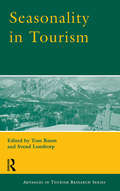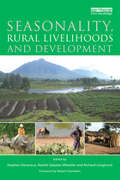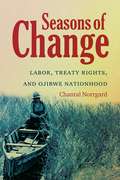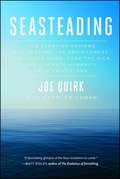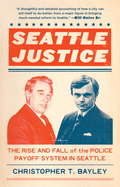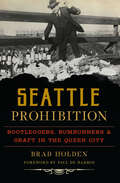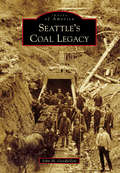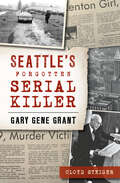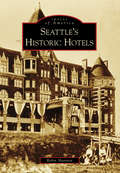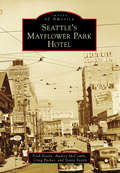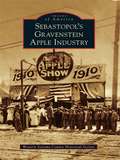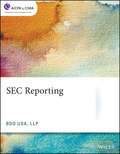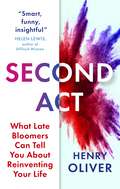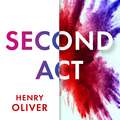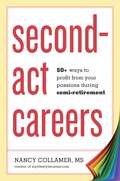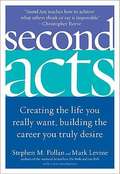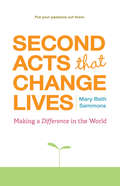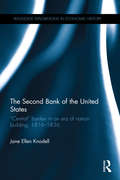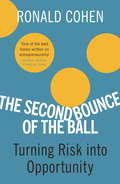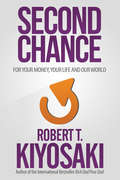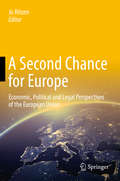- Table View
- List View
Seasonality in Tourism (Advances In Tourism Research Ser.)
by Tom Baum Svend LundtropSeasonal variation in demand is a reality for most tourism destinations. This work provides a balanced overview of the evidence and issues relating to tourism seasonality using European, North American and Pacific Rim cases and research evidence.
Seasonality, Rural Livelihoods and Development
by Stephen Devereux Rachel Sabates-Wheeler Richard LonghurstSeasonality is a severe constraint to sustainable rural livelihoods and a driver of poverty and hunger, particularly in the tropics. Many poor people in developing countries are ill equipped to cope with seasonal variations which can lead to drought or flood and consequences for agriculture, employment, food supply and the spread of disease. The subject has assumed increasing importance as climate change and other forms of development disrupt established seasonal patterns and variations. This book is the first systematic study of seasonality for over twenty years, and it aims to revive academic interest and policy awareness of this crucial but neglected issue. Thematic chapters explore recent shifts with profound implications for seasonality, including climate change, HIV/AIDS, and social protection. Case study chapters explore seasonal dimensions of livelihoods in Africa (Ethiopia, Kenya, Malawi), Asia (Bangladesh, China, India), and Latin America (Peru). Others assess policy responses to adverse seasonality, for example through irrigation, migration and seasonally-sensitive education. The book also includes innovative tools for monitoring seasonality, which should enable more appropriate responses.
Seasons of Change
by Chantal NorrgardFrom the 1870s to the 1930s, the Lake Superior Ojibwes of Minnesota and Wisconsin faced dramatic economic, political, and social changes. Examining a period that began with the tribe's removal to reservations and closed with the Indian New Deal, Chantal Norrgard explores the critical link between Ojibwes' efforts to maintain their tribal sovereignty and their labor traditions and practices. As Norrgard explains, the tribe's "seasonal round" of subsistence-based labor was integral to its survival and identity. Though encroaching white settlement challenged these labor practices, Ojibwe people negotiated treaties that protected their rights to make a living by hunting, fishing, and berrying and through work in the fur trade, the lumber industry, and tourism. Norrgard shows how the tribe strategically used treaty rights claims over time to uphold its right to work and to maintain the rhythm and texture of traditional Ojibwe life.Drawing on a wide range of sources, including New Deal-era interviews with Ojibwe people, Norrgard demonstrates that while American expansion curtailed the Ojibwes' land base and sovereignty, the tribe nevertheless used treaty-protected labor to sustain its lifeways and meet economic and political needs--a process of self-determination that continues today.
Seasteading: How Floating Nations Will Restore the Environment, Enrich the Poor, Cure the Sick, and Liberate Humanity from Politicians
by Joe Quirk Patri FriedmanTwo-thirds of our globe is Planet Ocean, not Planet Earth.Imagine a vast new source of sustainable and renewable energy that would also bring more equitable economies. A previously untapped source of farming that could produce significant new sources of nutrition. Future societies where people could choose the communities they want to live in, free from the restrictions of conventional citizenship. This bold vision of our near future as imagined in Seasteading attracted the powerful support of Silicon Valley’s Peter Thiel—and it may be drawing close to reality. Our planet is suffering from serious environmental problems: coastal flooding due to severe storms caused in part by atmospheric pollution and diminishing natural resources among them. But the seas can be home to a new breed of pioneers, seasteaders, who are willing to homestead the Blue Frontier. Oil platforms and cruise ships already inhabit the waters; now it’s time to take the next step to full-fledged ocean civilizations. Joe Quirk and Patri Friedman show us how cities built on floating platforms in the ocean will work, and they profile some of the visionaries who are implementing basic concepts of seasteading today. An entrepreneur’s dream, these floating cities will become laboratories for innovation and creativity. Seasteading may be visionary, but it already has begun proving the adage that yesterday’s science fiction is tomorrow’s science fact. Welcome to seavilization.
Seattle Justice
by Christopher T. BayleyThis is the story of one of the youngest county prosecutors in the country whose mission was to finally end the system of vice and corruption that had infiltrated Seattle's police department, municipal departments, and even the mayor's office. In the late 1960s, Christopher T. Bayley was a young lawyer with a fire in his belly to break the back of Seattle's police payoff system, which was built on licensing of acknowledged illegal activity known as the "tolerance policy." Against the odds, he became the youngest prosecutor in King County (which includes Seattle). Six months into his first term, he indicted a number of prominent city and police officials. Bayley shows how vice and payoffs became rules of the game in Seattle, and what it took to finally clean up the city.
Seattle Prohibition: Bootleggers, Rumrunners, & Graft in the Queen City (American Palate Ser.)
by Brad HoldenProhibition consumed Seattle, igniting a war that lasted nearly twenty years and played out in the streets, waterways, and even town hall. Roy Olmstead, formerly a Seattle police officer, became the King of the Seattle Bootleggers, and Johnny Schnarr, running liquor down from Canada, revolutionized the speedboat industry. Frank Gatt, a south Seattle restaurateur, started the state&’s biggest moonshining operation. Skirting around the law, the Coast Guard and the zealous assistant director of the Seattle Prohibition Bureau, William Whitney, was no simple feat, but many rose to the challenge. Author Brad Holden tells the spectacular story of Seattle in the time of Prohibition.&“When you live in Seattle long enough, at a certain point you need to sit down and read a history that ties together the half-heard stories about vice dens and crooked cops you&’ve pieced together from locals at the bar. Brad Holden&’s &“Seattle Prohibition,&” a slim but dense account of Seattle shortly before, during and after Prohibition, is an excellent place to start. This is a riveting drama of plainly told facts.&” —The Stranger&“In a rapidly evolving city with little sense of its past, Brad Holden is Seattle&’s new, essential cultural historian. His book builds a better understanding of how we arrived at the present and does it with color, wit and artful storytelling.&” —Thomas Kohnstamm, author of Lake City &“Elements of this story may be familiar to those who know some regional history, but there are some fascinating tidbits, such as how the booze trade contributed to the city&’s first radio station.&” —The Tacoma News Tribune
Seattle's Coal Legacy (Images of America)
by John M. GoodfellowIn the 1880s, Seattle became a major coal port in the United States. By 1908, Puget Sound was the third-largest coal port, after New York and Baltimore. For Seattle, the major coal mines were in Issaquah, New Castle, Renton, and Black Diamond, with many other smaller mines throughout King County. Until the petroleum revolution, Seattle exported most of its coal to San Francisco. Because of coal, Seattle became a center for skilled engineers, machinists, and miners for the maritime, manufacturing, mining, and railroad industries, differentiating itself from other lumber towns on Puget Sound. Seattle's Coal Legacy is the story of a frontier town going through an industrial revolution in its own time. The skills and knowledge developed during the coal era-engineering, finance, transportation, manufacturing, etc.-made Seattle the major city it is today.
Seattle's Forgotten Serial Killer: Gary Gene Grant (True Crime)
by Cloyd Steiger&“An in-depth look at the 1971 trial of a serial killer who&’s been mostly forgotten—except to those who were forever impacted&” (The Seattle Times).In 1969, the body of a young woman was discovered in the woods of Renton, Washington, rocking the communities along Puget Sound. Three more brutal murders followed, drawing the attention of multiple police agencies as they tried to piece together the meager clues left behind. The seemingly unrelated cases challenged detectives, who struggled to realize they were all connected to one man: Gary Gene Grant. Before the term &“serial killer&” was even coined, Grant stalked his prey, destroying lives and families while walking unseen among the masses. Decades later, his crimes have all but been forgotten.Join author and homicide investigator Cloyd Steiger as he uncovers the story of the murderer who slipped through the cracks of history.
Seattle's Historic Hotels (Images of America)
by Robin ShannonMary Ann Conklin, also known as "Madame Damnable," ran Seattle's first hotel, the Felker House, which burned to the ground in the Great Seattle Fire of 1889. The Rainier Hotel was erected quickly following the Great Seattle Fire but razed around 1910. The Denny Hotel, an architectural masterpiece later known as the Washington Hotel, was built in 1890 but torn down in 1907 during the massive regrade that flattened Denny Hill. Upon opening in 1909, the Sorrento Hotel was declared a "credit to Seattle" by the Seattle Times. The Olympic Hotel was the place for Seattle's high society throughout the 1920s. The Hotel Kalmar was a workingman's hotel built in 1881 and was razed for the Seattle tollway. The Lincoln Hotel was destroyed by a tragic fire in 1920, along with its rooftop gardens. The famous and grand Seattle Hotel in Pioneer Square was replaced by a "sinking ship" parking garage, thus sparking preservationists to band together to establish Pioneer Square as a historic district.
Seattle's Mayflower Park Hotel (Images of America)
by Craig Packer Stevie Festin Audrey Mccombs Trish FestinThe Mayflower Park Hotel started life as the Bergonian Hotel on July 16, 1927. One of Seattle's first uptown hotels, it was designed by architect B. Dudley Stuart and built by Stephen Berg at a cost of $750,000. In the midst of the Great Depression, the hotel was sold and renamed Hotel Mayflower. In 1948, Washington State legalized cocktail lounges, and the Hotel Mayflower became Seattle's first hotel to open one. In the ensuing decades, Seattle prospered, and it hosted the 1962 World's Fair with its symbolic Space Needle. By the 1970s, Seattle was in a deep recession, and the hotel had become sadly neglected. In 1974, Birney and Marie Dempcy formed a limited partnership to purchase the hotel and renamed it the Mayflower Park Hotel. Restoration started immediately, and after 40 years, the Dempcys remain dedicated to the tradition of making the Mayflower Park Hotel "Quite Simply, One of a Kind."
Sebastopol's Gravenstein Apple Industry
by Western Sonoma County Historical SocietyThe Gravenstein apple has been etched into the identity of Sebastopol, California, which is one of the few places on earth to have extensively grown this elusive apple. The Gravenstein is an early apple whose only failing is perishability, but it is celebrated for its superior flavor. Yet Luther Burbank attempted to improve on the Gravenstein, producing the Winterstein and the Bonita for home gardeners. During the last 127 years, the Gravenstein has added millions of dollars to the local economy. It has provided a reason for celebrations, from the 1910 Apple Show to today's Apple Blossom Festival and Gravenstein Apple Fair. This is the Gravenstein's story, from its European roots to small-town homage, and the part this special apple has played in one community--and the reason the current decline in apple acreage is mourned.
SEC Reporting (AICPA)
by BDO USAThis title clarifies new, difficult, and important reporting and disclosure requirements for SEC Reporting. You'll learn: The latest SEC developments and hot buttons. How to apply regulations S-X, S-K, and other SEC guidance. How to prepare and review financial statements and their related disclosures. It includes AS 3101, The Auditor's Report on an Audit of Financial Statements When the Auditor Expresses an Unqualified Opinion.
Secom: Managing Information Security in a Risky World
by Robert O. Austin F. Warren Mcfarlan Robert D. AustinExamines the type of security that is appropriate for an Internet company to have on its site. Focuses on a 20-person electronic e-commerce company trying to decide what parts of the information security product line they should acquire from the largest security service company in Japan, Secom. The services include everything from server hosting, advanced housing, firewall intrusion detection, etc. Introduces the wide range of products that can be used to ensure secure operations.
Second Act: What Late Bloomers Can Tell You About Success and Reinventing Your Life
by Henry Oliver"Henry Oliver is a rare talent: smart, funny and insightful. SECOND ACT showcases his wide reading, deep understanding and playful prose style. Read this book to discover why it's never too late for a second act in your own life."HELEN LEWIS, author of Difficult WomenHave you ever dreamed that you might be far more successful than you are today? Our society tells us over and over that if we're going to achieve anything, we'd better do it while we're young. But whether you're at the start of your career, sensing you're on the wrong path, or feeling unsettled later in life, you're likely wondering just how to reinvent yourself? Have you left it too late?This book has answers. Late bloomers - individuals who experience significant success later in life - offer lessons for people who feel frustrated. This book encourages people to think about themselves as potential late bloomers and to discover and encourage and advocate for late blooming in others. After all, it's never too late to discover our hidden talents and our accomplish our goals - the road to success is never as straightforward as we are lead to believe. Julia Child didn't discover that she loved to cook until she was thirty-seven. Vera Wang started her design business at forty. And Michelangelo painted The Last Judgment in his sixties.This inspiring, passionate book combines wonderful storytellingwith fascinating new research, to shift expectations around our life trajectories. You'll discover a range of blueprints for self-reinvention, pairing the newest insights from psychology and neuroscience with late bloomers' remarkable life stories, from Penelope Fitzgerald to Samuel Johnson, from Frank Lloyd-Wright to Malcolm X.
Second Act: What Late Bloomers Can Tell You About Success and Reinventing Your Life
by Henry Oliver"Henry Oliver is a rare talent: smart, funny and insightful. SECOND ACT showcases his wide reading, deep understanding and playful prose style. Read this book to discover why it's never too late for a second act in your own life."HELEN LEWIS, author of Difficult WomenHave you ever dreamed that you might be far more successful than you are today? Our society tells us over and over that if we're going to achieve anything, we'd better do it while we're young. But whether you're at the start of your career, sensing you're on the wrong path, or feeling unsettled later in life, you're likely wondering just how to reinvent yourself? Have you left it too late?This book has answers. Late bloomers - individuals who experience significant success later in life - offer lessons for people who feel frustrated. This book encourages people to think about themselves as potential late bloomers and to discover and encourage and advocate for late blooming in others. After all, it's never too late to discover our hidden talents and our accomplish our goals - the road to success is never as straightforward as we are lead to believe. Julia Child didn't discover that she loved to cook until she was thirty-seven. Vera Wang started her design business at forty. And Michelangelo painted The Last Judgment in his sixties.This inspiring, passionate book combines wonderful storytellingwith fascinating new research, to shift expectations around our life trajectories. You'll discover a range of blueprints for self-reinvention, pairing the newest insights from psychology and neuroscience with late bloomers' remarkable life stories, from Penelope Fitzgerald to Samuel Johnson, from Frank Lloyd-Wright to Malcolm X.
Second Act: What Late Bloomers Can Tell You About Success and Reinventing Your Life
by Henry Oliver"Henry Oliver is a rare talent: smart, funny and insightful. SECOND ACT showcases his wide reading, deep understanding and playful prose style. Read this book to discover why it's never too late for a second act in your own life."HELEN LEWIS, author of Difficult WomenHave you ever dreamed that you might be far more successful than you are today? Our society tells us over and over that if we're going to achieve anything, we'd better do it while we're young. But whether you're at the start of your career, sensing you're on the wrong path, or feeling unsettled later in life, you're likely wondering just how to reinvent yourself? Have you left it too late?This book has answers. Late bloomers - individuals who experience significant success later in life - offer lessons for people who feel frustrated. This book encourages people to think about themselves as potential late bloomers and to discover and encourage and advocate for late blooming in others. After all, it's never too late to discover our hidden talents and our accomplish our goals - the road to success is never as straightforward as we are lead to believe. Julia Child didn't discover that she loved to cook until she was thirty-seven. Vera Wang started her design business at forty. And Michelangelo painted The Last Judgment in his sixties.This inspiring, passionate book combines wonderful storytellingwith fascinating new research, to shift expectations around our life trajectories. You'll discover a range of blueprints for self-reinvention, pairing the newest insights from psychology and neuroscience with late bloomers' remarkable life stories, from Penelope Fitzgerald to Samuel Johnson, from Frank Lloyd-Wright to Malcolm X.
Second-Act Careers: 50+ Ways to Profit from Your Passions During Semi-Retirement
by Nancy CollamerA career guide that rethinks the golden years, this handbook offers 50+ income models for creating flexible, fulfilling, and profitable work during the encore stage of one's career.RETHINK YOUR RETIREMENT For many people, retirement is no longer a trifecta of golf, grandkids, and gardening-- it's an opportunity for new pursuits that involve both earning income and exploring personal passions. If you're planning for retirement or already at "retirement age" but want to continue working--whether to supplement your income or to stay mentally and physically active--veteran career coach Nancy Collamer shows how to identify your favorite interests and expertise and repackage them into more than fifty ways to earn income. These second acts range from the traditional (part-time employment, consulting) to newer Internet-based options (teaching online, writing a blog). With a prescriptive approach to securing second-act careers that are flexible, fulfilling, and fun, this book offers a wide variety of income-generating examples as well as exercises to clarify your lifestyle goals and help you plan for your next move. Second-Act Careers shows how to create a profitable and meaningful semi-retirement on your own terms and in your own way.
Second Acts
by Stephen M. Pollan Mark LevineSecond Acts is a guide to reinventing your life. Whether you wish to change careers, move to a more desirable part of the country, start a business, write a novel, or drop everything to pursue a life dream, Stephen Pollan offers a powerful message ofhope and guidance that has benefited his own clients. Through a series of exercises, you will develop a comprehensive "script" for your second act-a step-by-step action plan that will lead you to the life you've always wanted.
Second Acts that Change Lives: Making a Difference in the World
by Mary Beth SammonsAre you realizing that the first half of your life is over? And you've been so busy concentrating on building a career or raising a family, or both, it has suddenly dawned on you that you may have lost yourself in the process and that the dreams you had when you were younger were set aside for more immediate concerns. Or are you frustrated that you have not had the time to truly give back? Mary Beth Sammons offers readers a chance to change all that in Second Acts That Change Lives. The book offers a collection of honest and inspiring stories delving into the lives of a community of mid-life trailblazers who wanted to make changes in their lives and found that as they reached inward for the strength to change, almost unanimously reached out to share their better self, their skills, their talents to make the world a better place.
The Second Bank of the United States: “Central” banker in an era of nation-building, 1816–1836 (Routledge Explorations in Economic History)
by Jane Ellen KnodellThe year 2016 marks the 200th anniversary of the founding of the Second Bank of the United States (1816-1836). This book is an economic history of an early central bank, the Second Bank of the United States (1816-36). After US President Andrew Jackson vetoed the re-chartering of the Bank in 1832, the US would go without a central bank for the rest of the nineteenth century, unlike Europe and England. This book takes a fresh look at the role and legacy of the Second Bank. The Second Bank of the United States shows how the Bank developed a business model that allowed it to make a competitive profit while providing integrating fiscal services to the national government for free. The model revolved around the strategic use of its unique ability to establish a nationwide system of branches. This book shows how the Bank used its branch network to establish dominance in select money markets: frontier money markets and markets for bills of exchange and specie. These lines of business created synergies with the Bank’s fiscal duties, and profits that helped cover their costs. The Bank’s branch in New Orleans, Louisiana, became its geographic centre of gravity, in contrast with the state-chartered banking system, which was already, by the 1820s, centred around New York. This book is of great interest to those who study banking and American history, as well as economic students who have a great interest in economic history.
The Second Bounce Of The Ball: Turning Risk Into Opportunity
by Ronald CohenA unique insider's guide to turning risk into opportunityIn business, everyone can see the first bounce of the ball. It is the second bounce that is uncertain. Ronald Cohen, one of the world's leading private-equity investors, argues that the entrepreneur's aim is to take advantage of that uncertainty: for it is only in situations of uncertainty that significant gains can be made. Putting it another way, successful entrepreneurs know how to turn risk into opportunity.The book is essential reading for entrepreneurs, wannabe entrepreneurs and all those who want to apply entrepreneurial approaches in all walks of life. It provides relevant background on the development of entrepreneurship and of the venture-capital and private-equity industry through the prism of Cohen's experience at Apax. It provides guidance about how to take advantage of business opportunity: the right people and the right money and the roles played by personality and luck and underlines the importance of ethics.
The Second Bounce Of The Ball: Turning Risk Into Opportunity
by Sir Sir Ronald Cohen'One of the best books written on entrepreneurship in recent years' FINANCIAL TIMES In business, everyone can see the first bounce of the ball. It is the second bounce that is uncertain. Ronald Cohen, one of the world's leading private-equity investors, argues that the entrepreneur's aim is to take advantage of that uncertainty: for it is only in situations of uncertainty that significant gains can be made. Putting it another way, successful entrepreneurs know how to turn risk into opportunity.The book is essential reading for entrepreneurs, wannabe entrepreneurs and all those who want to apply entrepreneurial approaches in all walks of life. It provides relevant background on the development of entrepreneurship and of the venture-capital and private-equity industry through the prism of Cohen's experience at Apax. It provides guidance about how to take advantage of business opportunity: the right people and the right money and the roles played by personality and luck and underlines the importance of ethics.
Second Captain First Choose: How to Create a Support Network and Get the Feedback You Need to Grow, Change, and Succeed
by Thomas J. DelongToo many high-need-for-achievement professionals think that they can't ask anyone for help if they're struggling. They need to come across as tough and independent, never "soft" or uncertain. If this sounds like you, you could become isolated and less open to growth and change--and therefore less and less effective. In this chapter, leadership expert Thomas DeLong argues that if you want to overcome your fears and gain the courage to stretch yourself--both as a person and as a professional--you need a support network made up of people who will give you honest, useful, timely advice and feedback. After explaining how to choose respected others who will tell you the truth in a supportive way, DeLong introduces SKS--"Stop doing, Keep doing, Start doing"--as a simple, highly effective tool for eliciting actionable feedback. Vivid personal examples, along with suggestions you can put into practice today, will start you on your way to forming a support network that will make you a stronger and more successful leader. This chapter was originally published as Chapter 11 of "Flying Without a Net: Turn Fear of Change into Fuel for Success."
Second Chance: for Your Money, Your Life and Our World
by Robert T. KiyosakiFew would argue with the fact that, on many fronts, we are a world in crisis. And there are two sides to every crisis, be it a leadership crisis, an economic crisis, an education crisis or a moral crisis. The two side to crisis are danger and opportunity.Robert Kiyosaki's new book, Second Chance...for Your Money and Your Life, uses the lessons from the past and a brutal assessment of the present to prepare readers to see--and seize--the future.If readers can train their minds to see what their eyes cannot, in a world that is becoming increasingly more 'invisible' and moving at a high rate of speed, they can have a second chance at creating the life they've always wanted.The global problems we face cannot be solved by the same minds and people who created them and today's world demands the ability to see the future and prepare for what lies ahead...prepare for the opportunities as well as the challenges.Like it or not, we are all involved in the greatest evolutionary event in human history. The Industrial Age is over and the Information Age continues to accelerate. The visible agents of change have become invisible...and harder to see. And the future belongs to those who can train their minds, use the past to see the future, and take the steps to create the positive change they want to see in their lives.Second Chance is a guide to understanding how the past will shape the future and how you can use Information Age tools and insights to create a fresh start. This book is a guide to facing head-on the dangers of the crises around us-and steps and tips for seizing the opportunities they present.
A Second Chance for Europe: Economic, Political and Legal Perspectives of the European Union
by Jo RitzenThis book calls upon us to rethink and reboot the European Union. The authors dissect the EU's many vulnerabilities: how some Member States are backsliding on the rule of law, freedom of the press, and control of corruption - and how globalization's 'discontents' are threatening the liberal international order. It examines the need for a common immigration policy; the need to rethink the unsustainable debt overhang of some Eurozone countries; and the need to use education to foster a European identity. Given the sum total of these vulnerabilities, the book argues, the EU may not survive beyond 2025 in its present form - that is, unless decisive action is taken. In turn, the book puts forward a number of workable solutions: a European economic model to secure full employment; a stronger European Court of Human Rights to counter systemic violations; a points-based immigration policy; clear exit options for the Eurozone; and an Open Education Area with a common second language. These solutions may reduce the number of EU countries, but would increase cohesion and overall survivability.
